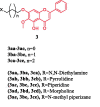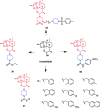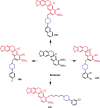Piperazine skeleton in the structural modification of natural products: a review
- PMID: 34080510
- PMCID: PMC8183565
- DOI: 10.1080/14756366.2021.1931861
Piperazine skeleton in the structural modification of natural products: a review
Abstract
Piperazine moiety is a cyclic molecule containing two nitrogen atoms in positions 1 and 4, as well as four carbon atoms. Piperazine is one of the most sought heterocyclics for the development of new drug candidates with a wide range of applications. Over 100 molecules with a broad range of bioactivities, including antitumor, antibacterial, anti-inflammatory, antioxidant, and other activities, were reviewed. This article reviewed investigations regarding piperazine groups for the modification of natural product derivatives in the last decade, highlighting parameters that affect their biological activity.
Keywords: Piperazine; natural product; pharmacological activity; structure–activity relationship.
Conflict of interest statement
No potential conflict of interest was reported by the author(s).
Figures













































































Similar articles
-
Piperazine scaffold: A remarkable tool in generation of diverse pharmacological agents.Eur J Med Chem. 2015 Sep 18;102:487-529. doi: 10.1016/j.ejmech.2015.07.026. Epub 2015 Jul 18. Eur J Med Chem. 2015. PMID: 26310894 Review.
-
Piperazine derivatives with central pharmacological activity used as therapeutic tools.Fundam Clin Pharmacol. 2019 Feb;33(1):13-24. doi: 10.1111/fcp.12408. Epub 2018 Sep 17. Fundam Clin Pharmacol. 2019. PMID: 30151922 Review.
-
Synthetic Protocols, Structural Activity Relationship, and Biological Activity of Piperazine and its Derivatives.Med Chem. 2024;20(8):753-780. doi: 10.2174/0115734064304396240415110015. Med Chem. 2024. PMID: 38685782 Review.
-
The potential of marine-derived piperazine alkaloids: Sources, structures and bioactivities.Eur J Med Chem. 2024 Feb 5;265:116081. doi: 10.1016/j.ejmech.2023.116081. Epub 2023 Dec 26. Eur J Med Chem. 2024. PMID: 38181652 Review.
-
Piperazine derivatives for therapeutic use: a patent review (2010-present).Expert Opin Ther Pat. 2016 Jul;26(7):777-97. doi: 10.1080/13543776.2016.1189902. Epub 2016 May 31. Expert Opin Ther Pat. 2016. PMID: 27177234 Review.
Cited by
-
An Update on the Implications of New Psychoactive Substances in Public Health.Int J Environ Res Public Health. 2022 Apr 17;19(8):4869. doi: 10.3390/ijerph19084869. Int J Environ Res Public Health. 2022. PMID: 35457736 Free PMC article. Review.
-
Design, synthesis, analgesic, antibacterial and docking studies of novel 8-piperazinylcaffeine carboxylate ionic liquids.RSC Adv. 2024 Sep 10;14(39):28669-28683. doi: 10.1039/d4ra06244b. eCollection 2024 Sep 4. RSC Adv. 2024. PMID: 39257660 Free PMC article.
-
Investigation of anti-microbial and cytotoxic potential of Streptomyces werraensis GRS9 derived from the sediments of river Ganga.Braz J Microbiol. 2025 Jun;56(2):863-882. doi: 10.1007/s42770-025-01642-9. Epub 2025 Mar 11. Braz J Microbiol. 2025. PMID: 40064810
-
Novel sulfonamides unveiled as potent anti-lung cancer agents via tumor pyruvate kinase M2 activation.RSC Med Chem. 2024 Jul 11;15(9):3070-3091. doi: 10.1039/d4md00367e. eCollection 2024 Sep 19. RSC Med Chem. 2024. PMID: 39309364 Free PMC article.
-
Syntheses and crystal structures of four 4-(4-nitro-phen-yl)piperazinium salts with hydrogen succinate, 4-amino-benzoate, 2-(4-chloro-phen-yl)acetate and 2,3,4,5,6-penta-fluoro-benzoate anions.Acta Crystallogr E Crystallogr Commun. 2023 Feb 9;79(Pt 3):151-156. doi: 10.1107/S2056989023001093. eCollection 2023 Feb 1. Acta Crystallogr E Crystallogr Commun. 2023. PMID: 36909994 Free PMC article.
References
-
- Shaquiquzzaman M, Verma G, Marella A, et al. . Piperazine scaffold: a remarkable tool in generation of diverse pharmacological agents. Eur J Med Chem 2015;102:487–529. - PubMed
-
- Chen F-H, Zhang L-B, Qiang L, et al. . Reactive oxygen species-mitochondria pathway involved in LYG-202-induced apoptosis in human hepatocellular carcinoma HepG(2) cells. Cancer Lett 2010;296:96–105. - PubMed
-
- Foley TL, Rai G, Yasgar A, et al. . 4-(3-Chloro-5-(trifluoromethyl)pyridin-2-yl)-N-(4- methoxypyridin-2-yl)piperazine-1-carbothioamide (ML267), a potent inhibitor of bacterial phosphopantetheinyl transferase that attenuates secondary metabolism and thwarts bacterial growth. J Med Chem 2014;57:1063–78. - PMC - PubMed
-
- Cao X, Zhang Y, Chen Y, et al. . Synthesis and biological evaluation of fused tricyclic heterocycle piperazine (piperidine) derivatives as potential multireceptor atypical antipsychotics. J Med Chem 2018;61:10017–39. - PubMed
Publication types
MeSH terms
Substances
LinkOut - more resources
Full Text Sources
